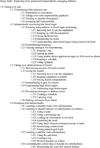Moving the Journey Towards Independence: Adolescents Transitioning to Successful Diabetes Self-Management
- PMID: 26190456
- PMCID: PMC5116197
- DOI: 10.1016/j.pedn.2015.06.005
Moving the Journey Towards Independence: Adolescents Transitioning to Successful Diabetes Self-Management
Abstract
Purpose: To gain a greater understanding of adolescent's experiences living with Type 1 diabetes mellitus (T1DM) and create a theoretical paradigm.
Methods: Grounded theory as described by Glaser was used. Fifteen in-depth interviews were conducted with adolescent's ages 11-15 with T1DM. Symbolic interactionism is the theoretical framework for grounded theory. Data were collected; transcribed, coded, and analyzed simultaneously using constant comparative analysis and findings were grounded in the words of participants.
Results: A theoretical model was created with the concept of "normalizing". Normalizing was defined as the ability to integrate diabetes into one's daily life to make diabetes 'part of me'. Phase four of the model, and the focus of this manuscript was "Moving the Journey towards Independence" and included: 1) taking over care, 2) experiencing conflict with parents, and 3) realizing diabetes is hard. The major task for adolescents in this phase was separating from parents to independently manage diabetes. The normalizing task for this phase was: "taking on the burden of care". Adolescents described challenges with independent care and increased parental conflict including: fearing needles, forgetting insulin, feeling embarrassed and believing that diabetes was a burden in their life. Additionally, juggling the multiple responsibilities of home, school and work along with managing a chronic illness during adolescence is challenging.
Conclusions: Transitioning to diabetes self-management is a challenge for adolescents. This model advances understanding of the moving processes in adolescents transitioning; additionally, hypotheses are presented that may be used for developing interventions to promote success in self-management.
Keywords: Adolescent; Conflict; Parent; Self-management; Type 1 diabetes.
Copyright © 2015 Elsevier Inc. All rights reserved.
Figures
References
-
- Babler EK, Strickland CJ. Normalizing : adolescent experiences in living with type 1 diabetes. 2013 from http://hdl.handle.net/1773/23599. - PMC - PubMed
Publication types
MeSH terms
Substances
Grants and funding
LinkOut - more resources
Full Text Sources
Other Literature Sources
Medical


